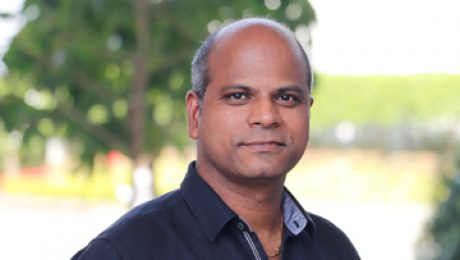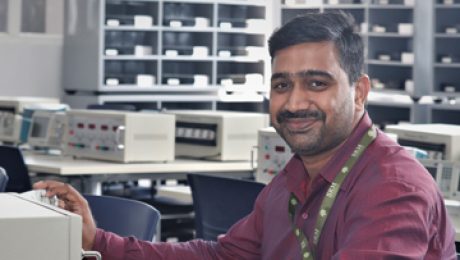DIGITAL HUMANITIES: HOW TECHNOLOGY AND COMPUTATIONAL SCIENCE IS SHAPING THE FUTURE OF THE LIBERAL ARTS.
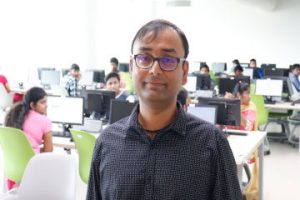 Dartmouth College, Hanover, New Hampshire: At Dartmouth’s April 2019 conference titled “The Marriage of Pre-Modern Literature and Computational Science” experts in the field of Digital Humanities, through a series of papers, will showcase new findings and insights on computational tools used to analyse their subjects, tools that have revolutionised research in the humanities. Three SRM Andhra Pradesh SLABS faculty: Dr. Prateek, Dr. Nibedita Bandyopadhyay and Dr. Rajni are attending the Dartmouth conference to enhance their knowledge of computational tools related to non-English languages, which in turn will allow them to advance their own digital humanities projects. Digital Humanities is a relatively new discipline where computer science and hermeneutics intersect to create new ways to expand traditional literary interpretation, particularly of older texts. The platform enables scholars to analyse global information on a piece of text or art using focused computational tools and thereby redefine the characteristics of the text.
Dartmouth College, Hanover, New Hampshire: At Dartmouth’s April 2019 conference titled “The Marriage of Pre-Modern Literature and Computational Science” experts in the field of Digital Humanities, through a series of papers, will showcase new findings and insights on computational tools used to analyse their subjects, tools that have revolutionised research in the humanities. Three SRM Andhra Pradesh SLABS faculty: Dr. Prateek, Dr. Nibedita Bandyopadhyay and Dr. Rajni are attending the Dartmouth conference to enhance their knowledge of computational tools related to non-English languages, which in turn will allow them to advance their own digital humanities projects. Digital Humanities is a relatively new discipline where computer science and hermeneutics intersect to create new ways to expand traditional literary interpretation, particularly of older texts. The platform enables scholars to analyse global information on a piece of text or art using focused computational tools and thereby redefine the characteristics of the text.
As Dr. Prateek explains it – “Franco Moretti, a leader in the digital field first drew the distinction between closed readings (the traditional way to read a text) and distant readings where computational tools are applied to vast computer generated data on the text. In classic Gothic literature for example, a closed reading is likely to bring up imagery of cathedrals and labyrinths. However, a large data base of Gothic writings analysed by digital tools sheds new light, new ways to look at the text not thought of before – like word usage, language frequency, and other observations not commonly associated with Gothic literature. The focus here is not on language per se, rather how language is being used to evoke emotions associated with Gothic literature. This is where the digital medium helps as it is not always physically possible to analyse 200 texts on a wide range of criteria.”
Dr. Prateek’s interest in digital humanities began during his PhD in theatre studies at the University of Queensland in Australia when his supervisor, Prof. Joanne Tompkins with some of the leading figures in Ibsen Studies published A Global Doll’s House, a project for which she looked at 3787 productions of Ibsen’s Doll’s House worldwide. The database included the year of the production, the production company’s political affiliations, the prevalent political landscape of the time, casting, particularly of the lead character of Nora Helmer as performed in different countries and settings. This new approach alerted Dr. Prateek to the digital tools Prof. Tompkins employed for a new gender analysis of the text as well as to explain the impact of the prevalent political framework on the production house. “Prof. Tompkins’ project threw new light on Doll’s House in terms of restating the historical record of that time period. This scope of data analysis on a piece of text is beyond what one scholar can accomplish.”
As he set about looking for a text he could relate to for a similar exercise Dr. Prateek settled upon Kalidasa’s ‘Shakuntala’. “I had seen numerous productions of Shakuntala and was familiar with the usual arguments as to why the play should be produced – the view of it as a romantic comedy, the eco-criticism within the forest setting, and feminist leanings. Also, post 1947 when the theatre of roots emerged in India Shakuntala became very valid. For a theatre company to be legit it had to do Shakuntala. Yet, with all this history around Shakuntala and what it evoked I felt with the technology available in digital humanities new readings could emerge.”
Presently, Dr. Prateek is accumulating and building the database of Shakuntala productions worldwide. “In India, I know what kind of companies I am dealing with, like Habib Tanvir, Bhopal Naya Theatre. One aspect of this project is how the computational tools can simulate what theatre would have looked like in that time period – for instance, in 1789 when William Jones did the first English translation- if it was an expression of proscenium theatre or street theatre, also a funding analysis – government or private organisations.”
Dr. Prateek is anticipating the conference at Dartmouth will help single out the computational tool best suited for his subject, the database and the goals of the project. “There are many different kinds of computational tools and the conference will be an opportunity to see how different subjects are being treated, the different applications being used.”.
Drawing a clear distinction between new readings of primary text and the new knowledge that emerges from computational science’s engagement with humanities, Dr. Prateek says, “We are not looking for a new reading of the primary text. Rather a new way of looking at it, a historiography about the productions of the play that in turn can shed new light on the text.”
Dr. Nibedita Bandyopadhyay on Environmental Digital Humanities.
- Published in News
SRM University, AP Taps Global Alliance that Empowers Millions of Students
New Delhi: Committed to empowering millions of students through expanding access to inter-disciplinary, inclusive, and tertiary education, SRM University, Andhra Pradesh, now joins College Board’s Indian Global Higher Education Alliance, to plug skills gaps and nurture global leaders. Driven by global collaboration and best practices, it accepts SAT score as part of admission processes.
- Published in News
Egypt is the top destination for SRM AP AIESEC 2019 Internships
SRM AP students will traverse the globe, to Egypt, Greece, Indonesia and Sri Lanka as part of AIESEC’s inaugural 6-8 week internships beginning May, 2019.
Aaditya Jain, one of five SRM AP representative members of AIESEC says, “The internships are structured to provide cross cultural experiences to students in more than 25 countries. This year, 10 of our students have been selected for two AIESEC programs – the Global Volunteer and Global Entrepreneur”.
- Published in News
Dr. E Karthikeyan
- Published in Assistant Professor, ECE Faculty, Faculty, SEAS
Dr. Anuj Deshpande
- Published in Assistant Professor, ECE Faculty, Faculty, SEAS
The growing impact of Nanotechnology on educational research and future markets
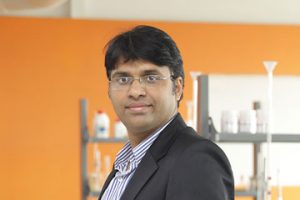 Nanomaterials are an increasingly important product of nanotechnologies with applications in medicine/healthcare, electronics, environmental health, technology and industry.
Nanomaterials are an increasingly important product of nanotechnologies with applications in medicine/healthcare, electronics, environmental health, technology and industry.
“The reason so many disciplines like chemistry, physics, engineering and biology are looking at this field is the exciting properties of materials at a nanoscale. It has broad application potential including bio-imaging diagnosis in the health sector.” says Dr. Nimai Mishra, Associate Professor of Chemistry at SRM AP.
Through his own research, Dr. Mishra, has attempted to develop a synthesis technique that can produce blinking free semi-conductor nanoparticles for increased energy savings in the use of light emitting diodes (LED), lasers and solar cells.
“For the past decade there has been considerable work in this field and in 2013 as a post-doctoral fellow at Los Alamos Lab in the U.S. I began to focus exclusively on this research.”
In April 2019, at the 2nd Global Outreach Research and Education Summit held at HITEX Exhibition Centre in Hyderabad Dr. Nimai Mishra’s work in nanomaterials was recognized with the “Young Researcher in Chemistry” award – an initiative of the Global Outreach Research & Education Association (GOREA).
Dr. Mishra, delivered a talk on “Nanochemistry: Impact in Device Fabrication” specifically, the control synthesis of nanoparticles via colloidal chemical route and their application in solar cell and LEDs.
For Dr. Mishra, whose education and research background includes IIT-Madras, NUS, Singapore, Los Alamos National Lab, USA and IIT-Genova, Italy, the summit was an opportunity to share ideas on how to meet challenges in higher education research.
At the summit, attended by over 100 delegates from all over the world, the papers presented were a diverse mix of subjects from materials science, digital dentistry, blockchain technology and the booming smart classroom market in India.
The Global Outreach Research & Education Association (GOREA) is a charitable foundation established in 2018 to promote technical advancement, entrepreneurship and skill development. GOREA achieves this through a global association of educationists, technologists, industrialists, business leaders and policymakers working towards the growth of research & education industry.
Earlier in February at IIT-BHU in Varanasi Dr. Mishra was awarded the Young Scientist Award” at the International Conference of Functional Nanomaterials (ICFNM-2019)” organized by IIT-BHU along with IIT-Guwahati and Society of Interdisciplinary Research in Material and Biology (SIRMB). The shortlisted six candidates were faculty from IIT, NIT, DBT Institute.
Of the event, Dr. Mishra said, “Speakers were from IIT, IISER and IISc. The good news is that most were aware of and admire the broad ambitious vision of the SRM AP university management.”
- Published in News, Research News
Dr. Nimai Mishra’s work in Nanomaterials recognized by leading education research institutes.
 In April 2019, at the 2nd Global Outreach Research and Education Summit held at HITEX Exhibition Centre in Hyderabad Dr. Nimai Mishra’s pioneering work in nanomaterials was recognized with the “Young Researcher in Chemistry” award, an initiative of the Global Outreach Research & Education Association (GOREA).
In April 2019, at the 2nd Global Outreach Research and Education Summit held at HITEX Exhibition Centre in Hyderabad Dr. Nimai Mishra’s pioneering work in nanomaterials was recognized with the “Young Researcher in Chemistry” award, an initiative of the Global Outreach Research & Education Association (GOREA).
At the summit, attended by over 100 delegates from all over the world, Dr. Mishra, delivered a talk on “Nanochemistry: Impact in Device Fabrication” specifically, the control synthesis of nanoparticles via colloidal chemical route and their application in solar cell and LEDs.
Through his research, Dr. Mishra, Associate Professor of Chemistry at SRM AP, has attempted to develop a synthesis technique that can produce blinking free semi-conductor nanoparticles for increased energy savings in the use of light emitting diodes (LED), lasers and solar cells.
“For the past decade there has been considerable work in this field and in 2013 as a post-doctoral fellow at Los Alamos Lab in the US I began to focus exclusively on this research. The technology has wide application potential including bio-imaging diagnosis in the health sector.”
For Dr. Mishra, whose education and research background includes IIT-Madras, NUS, Singapore, Los Alamos National Lab, USA and IIT-Genova, Italy, the summit was an opportunity to share ideas on how to meet challenges in higher education research.
The papers presented at the summit were a diverse mix of subjects from materials science, digital dentistry, blockchain technology and the booming smart classroom market in India.
The Global Outreach Research & Education Association (GOREA) is a charitable foundation established in 2018 to promote technical advancement, entrepreneurship and skill development. GOREA achieves this through a global association of educationists, technologists, industrialists, business leaders and policymakers working towards the growth of research & education industry.
Earlier in February at IIT-BHU in Varanasi Dr. Mishra was awarded the Young Scientist Award” at the International Conference of Functional Nanomaterials (ICFNM-2019)” organized by IIT-BHU along with IIT-Guwahati and Society of Interdisciplinary Research in Material and Biology (SIRMB). The shortlisted six candidates were faculty from IIT, NIT, DBT Institute.
Of the event, Dr. Mishra said, “Speakers were from IIT, IISER and IISc. The good news is that most were aware of the work being done at SRM AP and admire the broad ambitious vision of the university management.”
- Published in News, Research News
SRM AP STUDENTS GRADUATE FROM THE 2019 SEMESTER ABROAD PROGRAM AT UC BERKELEY WITH AN IMPRESSIVE RECORD OF WINS.
13 students from SRM AP completed the Semester Abroad program at UC Berkeley, California capping a spectacular season of programs like ETH Denver (the world’s biggest Ethereum Blockchain Hackathon and Conference; TensorFlow Development Summit (the largest event for all the Machine Learning users); and GDC 2019 (the biggest gaming conference in San Francisco.
- Published in News
Digital Environmental Humanities – Challenges and Possibilities
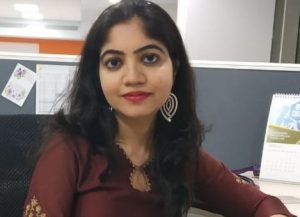 “I analyse texts that reflect the relationship between literature and environment with an emphasis on issues like pollution, resource crises, unchecked development and species extinction.” says Dr. Nibedita Bandyopadhyay who did her Ph.D. in English at IIT Kanpur with a specialisation in Environmental Humanities. Her journal papers and book chapters have appeared in reputed publications like Taylor and Francis and Lexington.
“I analyse texts that reflect the relationship between literature and environment with an emphasis on issues like pollution, resource crises, unchecked development and species extinction.” says Dr. Nibedita Bandyopadhyay who did her Ph.D. in English at IIT Kanpur with a specialisation in Environmental Humanities. Her journal papers and book chapters have appeared in reputed publications like Taylor and Francis and Lexington.
One example of the kind of literary text she speaks of is Ruchir Joshi’s The Last Jet-Engine Laugh, a novel that touches on the subject of resource capitalisation while exploring the generation gap in a Gujarati family over a century of political and social turmoil in post-colonial India.
In 2016, upon an invitation from the American Studies Association, Dr. Bandyopadhyay presented a paper on environmental humanities at a conference in Denver, Colorado. The following year she got a tuition award to participate at a conference in Cornell University’s ‘School of Criticism and Theory,’ where her mentor was historian Dr. Faisal Devji, from the Oxford University faculty. “It was a workshop where we analysed texts on the tenets of literary theory and criticism such as feminism, post-colonialism, eco-criticism and cultural studies”.
For Dr. Bandyopadhyay the April 2019 Dartmouth conference on digital humanities was notable for both raising concerns about technology and presenting opportunities in preservation and analysis of literary and cultural texts. She emphasises that digital humanities can lead to increased interdisciplinary research that will be fruitful to her domain as well because environmental humanities is a field which constantly engages itself with other fields of research.
“Even though traditionally ecocriticism and digital technologies have been in conflict, I see some interesting possibilities. Many eco-critics see modern technology as a major contributor to carbon dioxide emissions and as essentially anti-environmental. It is understandable how and why experts in environmental studies would resist adopting digital technologies at the heart of digital humanities. But if we judiciously combine ecocriticism and digital technologies, this will yield some remarkable changes.” Nibedita says.
The Dartmouth conference was highly successful in its attempt to dispel some of these doubts. One of the keynote speakers, Prof. Sukanta Choudhuri of Kolkata’s Jadavpur University spoke about a project that digitalizes and records works by writers like Rabindranath Tagore. Dr. Bandyopadhyay shares some of her memories of the conference session: “I raised the question of the numerous regional Bengali dialects that can be found from West Bengal to Bangladesh and how to reconcile these variations and differences, and most importantly, the mode of approach. It is a good idea to make digitised versions of classical texts but these must be made available to the Third World countries. It needs to be open to a wide audience, the public at large. Or else it has no meaning.” Here again, Dr. Bandyopadhyay points out the hesitation among some scholars of conventional humanities to adopt digital technologies and how the benefits once clearly understood can help overcome the diffidence: “They are just not comfortable with the medium. We need to build a real collaboration between Computer Science and Humanities because digitalisation depends on the operation of programming languages that belong to computer science. Digital technologies can in fact help in three important ways – digitization can record certain lost texts on environmental studies, simple online tools like hyperlinks can connect a large community of users to digitised texts, and computational technologies like Voyant can provide analysis, and this applies to environmental studies too”.
The computational tools in digital humanities are not confined to literary boundaries. Dr. Bandyopadhyay points out how these technologies can also access the natural world. “Digital tools can help to record the population and extinction rates of species in the natural world as well as take note of global warming and climate change. It is a new and challenging approach as not much work has been done in this area of research.”
In the coming semesters at SRM AP, Dr. Bandyopadhyay, who has taught Communicative English to SEAS students and creative writing and fiction analysis to SLABS students, will look to infuse SLABS course work with elements of digital and computational tools and introduce students to the immense possibilities. “For example, once we select a text and create a situational context, the students, many of whom come from technological backgrounds, can actively participate in digitisation exercises, access computational tools and even develop new programs to expand research and facilitate the analysis of literary texts. It will make the journey even more exciting for them.”
- Published in News
ISCA committee visit SRM AP to organize 108th Indian Science Congress
 May 2019: A three member committee of the Indian Science Congress Association (ISCA) consisting of Dr. Vijay Laxmi Saxena, the General President (Elect), Dr. Manoj Kumar Chakraborty, the immediate past President of ISCA and Dr. Ashok Kumar Saxena, the past General President of ISCA visited SRM University-AP, Amaravati on 16th May and held discussions to organize the 108th Indian Science Congress at SRM University-AP, Amaravati between 3-7 January, 2021.
May 2019: A three member committee of the Indian Science Congress Association (ISCA) consisting of Dr. Vijay Laxmi Saxena, the General President (Elect), Dr. Manoj Kumar Chakraborty, the immediate past President of ISCA and Dr. Ashok Kumar Saxena, the past General President of ISCA visited SRM University-AP, Amaravati on 16th May and held discussions to organize the 108th Indian Science Congress at SRM University-AP, Amaravati between 3-7 January, 2021.
Dr. P. Sathyanarayanan, President, SRM University-AP, Amaravati, Prof. D. Narayana Rao, Past General President of ISCA and Pro Vice Chancellor, Dr. D. Gunasekaran, Registrar and Dr. B. Siva Kumar, Dy. Registrar welcomed the high level committee members. Dr. P. Sathyanarayanan chaired the meeting.
The ISCA committee along with senior functionaries of the university visited lecture halls, halls for plenary sessions, hostel accommodation, the inauguration and science exhibition venues and other facilities. Prof. D. Narayana Rao made a presentation on SRM University-AP, Amaravati and Dr. B. Siva Kumar explained to the committee the logistic facilities available at the university to organize the Indian Science Congress.
The Indian Science Congress Association comprises eminent and established scientists, academicians, planners and science administrators of the government of India funding agencies and research scholars. The Indian Science Congress is held annually during 3-7 January. India has the unique distinction where a major science event is customarily inaugurated by the nation’s Prime Minister who then unravels the scientific agenda of the country before a large and wide scientific community.
The Indian Science Congress also provides an opportunity for scientists and academicians of different disciplines to interact and formulate interdisciplinary research programs.
According to Prof. D. Narayana Rao, the ISCA committee were very much convinced that SRM University-AP, Amaravati has the necessary facilities, expertise, and commitment to organize the Indian Science Congress. “Dr. P. Sathyanarayanan and I are hopeful that the university will have the opportunity to organize the event in January 2021 and this prestigious opportunity will enable SRM AP to gain exposure to varied scientific research possibilities which will further improve its research programs and facilities.”
- Published in News


